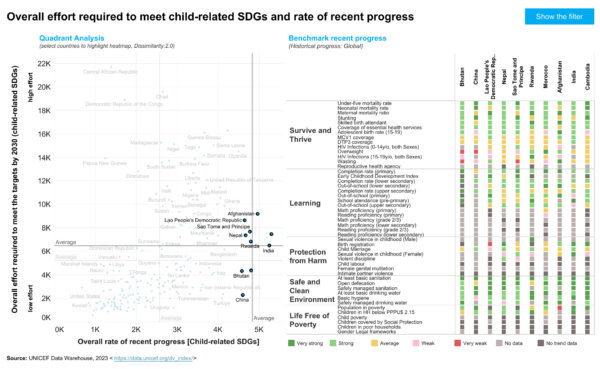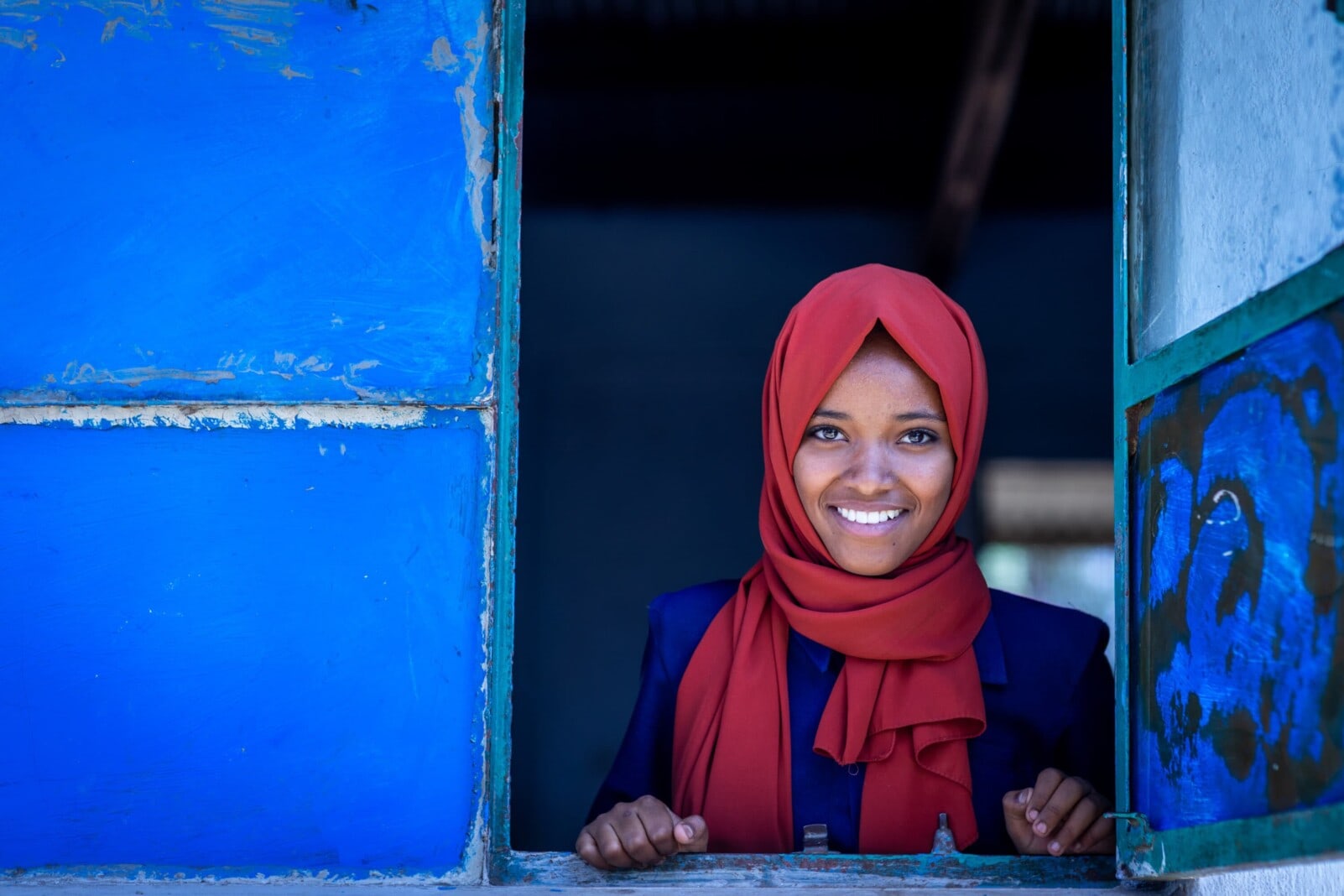Every child counts. The 2030 Agenda for Sustainable Development puts the principles of equality and non-discrimination at its heart, with a commitment to leave no one behind and reach those furthest behind first. Centring children in our efforts to drive sustainable development is a human rights imperative with the power to break harmful cycles of poverty and continued rights violations. But as the midpoint of our vision for a more equitable world nears, how successful have we been in bettering the lives of children?
To answer this question, UNICEF examined available data on the 48 child-related Sustainable Development Goal (SDG) indicators which the agency regularly monitors. Organized around five domains of child well-being – Survive and Thrive, Learning, Protection from Harm, Safe and Clean Environment and Life free from Poverty – these indicators capture the breadth of children’s lived experiences. When viewed together – rather than as individual sectors – they provide a rich, nuanced picture of children’s lives that tell us which children are thriving and which children are being left behind.
There are critical gaps in child-related SDG data
Due to limited data availability, there is much that remains unknown about how close or far we are from reaching the 48 child-related SDG targets: On average, national-level data are available for nearly half of these indicators. In high-income countries, there is a greater lack of child-related data that meet international standards when compared to data quality in low-income countries, in part because most monitoring in these countries relies on country-specific administrative data systems. This two-fold problem – a widespread lack of data availability combined with a lack of quality data — compromises our ability to track children’s progress and identify the children being left behind.
And today, a child born in a low-income country is seven times more likely to live in a country where child-related SDGs require acceleration than a child born in a high-income country. An estimated 150 million children – a mere 6 per cent of the child population – live in 11 countries where 50 per cent of child-related targets have been met, which is, the highest level of achievement globally.
The importance of benchmarking child-related SDGs for progress and accountability
At this midway point of the 2030 Agenda, it is critical that countries hone their strategies, fine-tune effective resource allocation and closely monitor their journey towards our shared vision of a better world for every child. The benchmarking of child-related SDG targets can help countries understand the effort and level of ambition required to reach their goals, which can then be met with concrete actions. By providing a comparative perspective, benchmarking allows countries to assess progress not only in absolute terms, but also in relation to regional partners and on a global level. This is vital for highlighting best practices, pinpointing where improvement is needed and fostering a sense of accountability.
Where countries are today and the effort that will be required to meet 2030 targets
In the analysis presented in the report, 2030 country targets were benchmarked against where countries are today to show the effort required to meet the target. Subsequently, the rate required to meet the target was benchmarked against a country’s recent rates of change – or how quickly progress has been accelerating. This helps countries understand where the targets can be met by doing more of the same as well as where the scaling up of what exists might suffice. The analysis provides valuable insights into how much additional effort might be required to achieve the child-related SDG targets while also, importantly, recognizing the results delivered by countries in the recent past. This approach provides a framework to assess ambition as well as the scale of action needed to realize it.
Analysis of the data show that differences between income groups across indicators are not systematic and the distance to target varies by income groups. However, across different income areas, Protection from Harm – stands out. In this domain, the 2030 targets — represented by orange dots — are significantly higher than others. This stark positioning reveals the disparate levels of effort required by countries based on their income. Particularly, low-income countries face a much steeper climb than their high-income counterparts. In other domains, such as Survive and Thrive, the dynamics are different. High-income countries on average have already met their 2030 targets, whereas other income groups lag behind. This discrepancy is influenced by the maturity of the indicators and the historical precedence of certain sectors.
Assessing what’s possible: Balancing countries’ ambition with realism
The analysis presented in the report then compares country targets against country performance over the recent past. Policymakers can use this information to guide and inform the most direct paths to achieving targets – and if these targets are realistic within the given timeframe.
For example, outcome areas and indicators in which historical and expected performance are aligned tell us that more of the same will suffice for the country to reach the target. Countries would, however, need to evaluate their approaches to ensure progress does not plateau. Conversely, cases where the expected performance needs to accelerate by a modest amount indicate that solutions are likely available. Countries might still need to expand scale, however, for which financing is a crucial enabler. Last but not least, themes and/or groups of countries where the rate of change needs to accelerate substantially highlight areas where ‘game-changers’ are needed.
These benchmarking metrics can be used (in countries where national SDG targets have been set) to have a conversation about whether those national targets are indeed both ambitious but realistic. And in countries without national SDG targets, the Government might usefully consider setting them to guide national policies and programs. Such conversations are critical to help build a shared understanding about the challenges and opportunities among stakeholders at the country level and can be part of a larger conversation with other development partners on how they can help fund this progress towards child-related SDGs.
Mobilizing political will
No matter how near or far a country is from reaching an SDG target, protecting and upholding every child’s rights and reaching these targets necessitates a high level of political will. Effective political engagement is intrinsically tied to financing mechanisms that work for children and to adequate resource mobilization that is utilized to support child well-being and development.
This political commitment must be informed and motivated by the fact that we cannot achieve the SDGs without making progress for children. It must also be informed by evidence: Evidence helps build a shared understanding about the challenges we face nationally, regionally and globally, and highlights opportunities for strategic acceleration. Evidence helps us see how the world can get back on track to realize the vision of the SDGs. The benchmarking exercise in this report provides the kind of evidence needed to understand the situation of children and offers a framework for better discussions and plans to improve that situation.
Explore the data
Click the image to explore the dashboard

